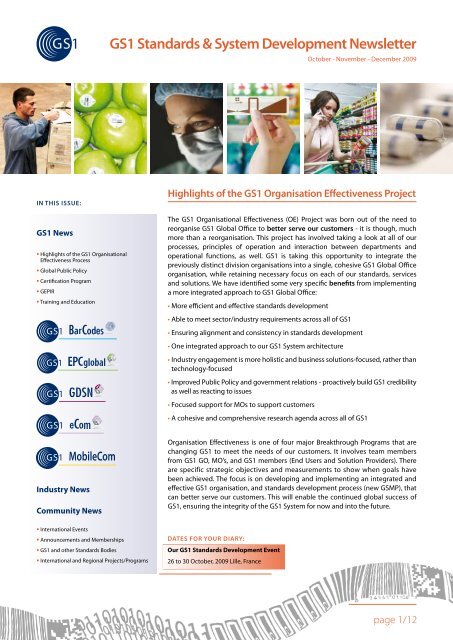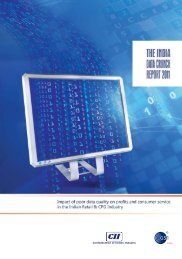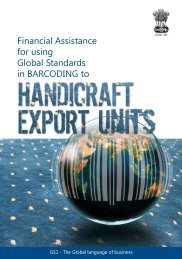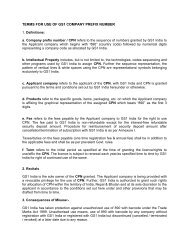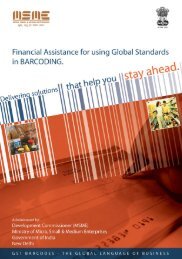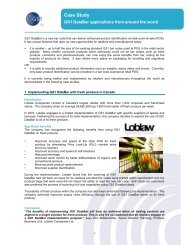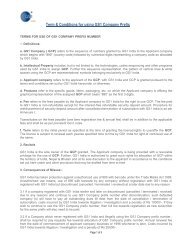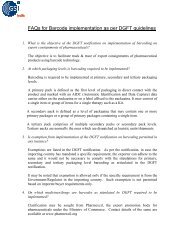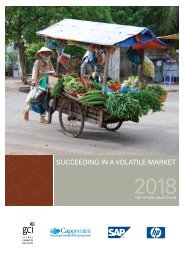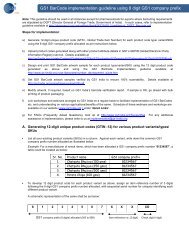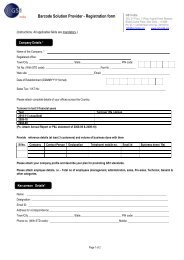GS1 Standards & System Development Newsletter - GS1 India
GS1 Standards & System Development Newsletter - GS1 India
GS1 Standards & System Development Newsletter - GS1 India
Create successful ePaper yourself
Turn your PDF publications into a flip-book with our unique Google optimized e-Paper software.
<strong>GS1</strong> <strong>Standards</strong> & <strong>System</strong> <strong>Development</strong> <strong>Newsletter</strong><br />
October - November - December 2009<br />
in this issue:<br />
<strong>GS1</strong> News<br />
• Highlights of the <strong>GS1</strong> Organisational<br />
Effectiveness Process<br />
• Global Public Policy<br />
• Certification Program<br />
• GEPIR<br />
• Training and Education<br />
Highlights of the <strong>GS1</strong> Organisation Effectiveness Project<br />
The <strong>GS1</strong> Organisational Effectiveness (OE) Project was born out of the need to<br />
reorganise <strong>GS1</strong> Global Office to better serve our customers - it is though, much<br />
more than a reorganisation. This project has involved taking a look at all of our<br />
processes, principles of operation and interaction between departments and<br />
operational functions, as well. <strong>GS1</strong> is taking this opportunity to integrate the<br />
previously distinct division organisations into a single, cohesive <strong>GS1</strong> Global Office<br />
organisation, while retaining necessary focus on each of our standards, services<br />
and solutions. We have identified some very specific benefits from implementing<br />
a more integrated approach to <strong>GS1</strong> Global Office:<br />
• More efficient and effective standards development<br />
• Able to meet sector/industry requirements across all of <strong>GS1</strong><br />
• Ensuring alignment and consistency in standards development<br />
• One integrated approach to our <strong>GS1</strong> <strong>System</strong> architecture<br />
• Industry engagement is more holistic and business solutions-focused, rather than<br />
technology-focused<br />
• Improved Public Policy and government relations - proactively build <strong>GS1</strong> credibility<br />
as well as reacting to issues<br />
• Focused support for MOs to support customers<br />
• A cohesive and comprehensive research agenda across all of <strong>GS1</strong><br />
Industry News<br />
Community News<br />
Organisation Effectiveness is one of four major Breakthrough Programs that are<br />
changing <strong>GS1</strong> to meet the needs of our customers. It involves team members<br />
from <strong>GS1</strong> GO, MO’s, and <strong>GS1</strong> members (End Users and Solution Providers). There<br />
are specific strategic objectives and measurements to show when goals have<br />
been achieved. The focus is on developing and implementing an integrated and<br />
effective <strong>GS1</strong> organisation, and standards development process (new GSMP), that<br />
can better serve our customers. This will enable the continued global success of<br />
<strong>GS1</strong>, ensuring the integrity of the <strong>GS1</strong> <strong>System</strong> for now and into the future.<br />
• International Events<br />
• Announcements and Memberships<br />
• <strong>GS1</strong> and other <strong>Standards</strong> Bodies<br />
• International and Regional Projects/Programs<br />
Dates for your diary:<br />
Our <strong>GS1</strong> <strong>Standards</strong> <strong>Development</strong> Event<br />
26 to 30 October, 2009 Lille, France<br />
page 1/12
To provide a central place for MO’s and members to locate<br />
information about the coming<br />
changes and what they mean<br />
to you, the OE News Website<br />
has been created and can be<br />
consulted on www.gs1.org/oe.<br />
On the site you will find specific<br />
i n f o r m a t i o n a b o u t t h e n e w<br />
Integrated <strong>Standards</strong> <strong>Development</strong> Process (new GSMP),<br />
Industry Engagement and MO Support. You will have the<br />
opportunity to review documents, comment, ask questions<br />
and register for webinars. We will continue to update this site<br />
as the project progresses.<br />
Sally Herbert<br />
President, <strong>GS1</strong> <strong>Standards</strong> &<br />
<strong>System</strong> <strong>Development</strong><br />
President, <strong>GS1</strong> GDSN, Inc.<br />
Global Public Policy<br />
Chris Adcock<br />
President,<br />
<strong>GS1</strong> Industry Engagement<br />
<strong>GS1</strong> Takes a Lead Role on EC RFID Privacy and Data Protection<br />
Recommendation Compliance<br />
Back in May of this year, the European Commission adopted<br />
a non-binding recommendation on the<br />
implementation of privacy and security<br />
principles for RFID applications. The<br />
<strong>GS1</strong> EPCglobal Public Policy Steering<br />
Committee was actively engaged in the<br />
stakeholder process and our involvement<br />
and insight helped shape the final draft.<br />
According to the Recommendation,<br />
each RFID application should undergo a<br />
Privacy Impact Assessment (PIA). A PIA is a self regulatory<br />
analysis of how information is handled to ensure that the<br />
conduct conforms to applicable legal, regulatory, and policy<br />
requirements regarding privacy and will help identify the<br />
risks and effects of collecting, maintaining and disseminating<br />
information in addition to examining and evaluating<br />
protections and alternative processes for handling<br />
information to mitigate potential privacy risks.<br />
As there are currently no set of guidelines for conducting a<br />
PIA in Europe, <strong>GS1</strong> EPCglobal agreed to take the initiative and<br />
produce the first draft of a European PIA Framework which<br />
was presented to the European Commission for feedback<br />
from other stakeholders. For more information on the EC<br />
Recommendation and PIA Framework, please contact Marisa<br />
Jimenez at marisa.jimenez@gs1.org.<br />
Project PURE Completed<br />
Project PURE, Promoting Understanding of RFID and the<br />
Environment, was launched in January 2007. It was an<br />
initiative supported by the United States Environmental<br />
Protection Agency to study how the infrastructure of RFID<br />
tags and readers being developed and deployed to improve<br />
supply chain management might be used to support postsale<br />
“end of life” recovery activities. <strong>GS1</strong> EPCglobal was<br />
conducting this project with representatives of companies<br />
involved in the supply chain for computers ranging from<br />
manufacturers and retailers to reusers, recyclers and waste<br />
disposers as well as academic experts and environmental<br />
authorities from both the state and federal level.<br />
The group found that there are substantial potential benefits<br />
from the use of RFID in the end of life processes, but that<br />
there still exists obstacles, including possible requirements<br />
for RFID tag deactivation at the point of sale in the interest of<br />
privacy protection. The most important short term benefits<br />
could be achieved by incorporating a marker on tags<br />
applied to computers for supply chain purposes, indicating<br />
that the item to which the tag is attached requires special<br />
handling. Special handling requirements might be imposed<br />
for a number of reasons including the presence of hazardous<br />
materials or the need for special security requirements. For<br />
more information regarding Project PURE, please contact<br />
Daniel Romm at dromm@epcglobalinc.org.<br />
Food Safety Legislation Proposed in US Congress<br />
In late July, the US House of Representatives passed<br />
House Bill 2749, the Food Safety Act of<br />
2009. The bill is now in the US Senate<br />
where it has been assigned to the<br />
Health, Education, Labor and Pensions<br />
Committee. The Food Safety Act of<br />
2009 was drafted in response to recent<br />
outbreaks of contaminated produce<br />
and other food products within the US.<br />
Under this legislation, food producers,<br />
manufacturers, processors, transporters,<br />
or holders are required to “maintain the<br />
full pedigree of the origin and previous distribution history<br />
of the food and to link that history with the subsequent<br />
distribution history.” Additionally, they must establish an<br />
interoperable record to ensure fast and efficient trace back.<br />
The proposed legislation calls for a pilot project to be conducted<br />
before a food traceability system is put in place. <strong>GS1</strong> is closely<br />
monitoring this bill and is speaking with relevant stakeholders<br />
and organizations about the benefits of a <strong>GS1</strong> solution. For<br />
more information regarding the Food Safety Act of 2009, please<br />
contact Daniel Romm at dromm@epcglobalinc.org.<br />
<strong>GS1</strong> <strong>Standards</strong> & <strong>System</strong> <strong>Development</strong> <strong>Newsletter</strong><br />
October - November - December 2009 page 2/12
<strong>GS1</strong> Certification Program<br />
The Certification Program is a neutral and authoritative<br />
s o u r c e f o r t e s t i n g a n d p r o v i d e s<br />
information regarding certified hardware<br />
and software products and/or services as<br />
well as the organizations which develop<br />
and manage them. The main purpose of<br />
the program is to facilitate the product<br />
development by solution providers and<br />
the selection by the end users giving<br />
them confidence that the products will<br />
perform to a high level of compliance<br />
to the mandatory requirements of the applicable standards<br />
and will facilitate integration with existing systems. Products<br />
carrying the certification mark have been rigorously tested<br />
and are certified to comply with <strong>GS1</strong> <strong>Standards</strong>, thus the<br />
end-user can be confident that the certified product will<br />
work predictably and speed up their implementations and<br />
decrease their costs.<br />
As part of the Organisation Effectiveness project, <strong>GS1</strong> is<br />
currently developing a certification framework among the<br />
various <strong>GS1</strong> certification areas. This will provide alignment<br />
among various <strong>GS1</strong> Certification areas (GDSN, <strong>GS1</strong> EPCglobal,<br />
AIDC, etc.) to ensure quality and consistency across different<br />
technological standards with regards to certification.<br />
The Global Electronic Party Information Register – GEPIR<br />
GEPIR is a distributed registry, internationally operated by<br />
the <strong>GS1</strong> Member Organisations, where users (companies<br />
and individuals) can request information about the actors<br />
involved in the global or local supply chain. Specifically,<br />
members can search and authenticate the <strong>GS1</strong> Global<br />
Company Prefix information for submitted:<br />
• Barcode - Global Trade Item Numbers (GTIN)<br />
• Global Location Number (GLN)<br />
• Serialized Shipping Container Codes (SSCC)<br />
• Company Name in any given country<br />
The GEPIR Technical <strong>Development</strong> Team (TDT) has recently<br />
been formalized within GSMP to align its development with<br />
<strong>GS1</strong> Technology <strong>Development</strong> processes. After discussions<br />
at the spring <strong>GS1</strong> GSMP Event in Los Angeles, California, the<br />
GEPIR TDT became a seated group within GSMP. They are<br />
now functioning to review and approve user submissions<br />
of suggested features and functionality via the <strong>GS1</strong> Change<br />
Request Submission <strong>System</strong>.<br />
Another part to this transition for the GEPIR Product is the<br />
authoring of a formal strategy. This strategy document<br />
maps the growth and development of this product within<br />
the <strong>GS1</strong> infrastructure, positioning it to play future roles<br />
in key functionalities such as Authentication and Mobile<br />
Commerce. This is the first formal <strong>GS1</strong> strategy to be applied to<br />
GEPIR supporting the goal to elevate it to a level of service<br />
operation necessary for continued growth and adoption. This<br />
new strategy is being delivered by the<br />
Global Office GEPIR Support Team at the<br />
upcoming <strong>GS1</strong> <strong>Standards</strong> <strong>Development</strong><br />
Event in Lille, France. The Strategy<br />
provides the framework details that will<br />
be implemented over time according to<br />
a Roadmap.<br />
Several of the planned improvements<br />
are designed to provide the security<br />
and continuity of operation necessary<br />
to support the continued growth of GEPIR. Additionally, the<br />
strategy focuses on the need to analyze the GEPIR network<br />
for determination on how best to configure the service so<br />
that the data can play an integral role in <strong>GS1</strong> Services in<br />
he future.<br />
Training and Education<br />
Ensuring continued competence is an important part of any<br />
training and education system. At <strong>GS1</strong>,<br />
we are following closely what is coming<br />
out of our standard development process<br />
to ensure our Member Organisations<br />
and users have access to up-to-date<br />
training material. There are currently 24<br />
eLearning modules and 30 classroom<br />
courses covering the technical and<br />
business aspects of a wide range of <strong>GS1</strong><br />
products, services and solutions. These<br />
courses can be accessed directly by <strong>GS1</strong> Staff members and<br />
can be accessed by our users through our <strong>GS1</strong> Member<br />
Organisations.<br />
You can find out more about the <strong>GS1</strong> Training and Education<br />
Program by looking at our eLearning catalogue which is<br />
available at http://learn.gs1.org/ or by accessing your <strong>GS1</strong><br />
Member Organisation website to check which classroom<br />
courses they are offering. Whether you are a GSMP expert or<br />
a beginner in the <strong>GS1</strong> world, you will always find the course<br />
you need to broaden your knowledge or expertise.<br />
<strong>GS1</strong> <strong>Standards</strong> & <strong>System</strong> <strong>Development</strong> <strong>Newsletter</strong><br />
October - November - December 2009 page 3/12
<strong>GS1</strong> BarCodes<br />
Fresh Foods Implementation Guide in 2010<br />
We will be bringing together experts from fresh food<br />
industries and <strong>GS1</strong> Members Organisations to develop a<br />
global fresh foods implementation guide for <strong>GS1</strong> DataBar.<br />
<strong>GS1</strong> DataBar provides supplier identification for fresh<br />
variable measure products. It enables<br />
more data to be delivered at Point-of-Sale<br />
such as expiration dates and lot numbers<br />
creating the opportunity for solutions<br />
supporting consumer safety programs,<br />
traceability, and quality control for<br />
fresh foods.<br />
Driven by users from fresh foods industries<br />
from around the world, the implementation<br />
guide will address the “How To” for<br />
implementing <strong>GS1</strong> DataBar symbols such as scanning, processing<br />
and printing requirements.<br />
Your participation and expertise are vital to its success! We<br />
will be putting together a team to champion this work effort<br />
and help the fresh foods industry meet their needs. You can<br />
join us at the <strong>GS1</strong> <strong>Standards</strong> <strong>Development</strong> Event in Lille for<br />
the Fresh Foods Work Group on Tuesday, October 27, 2009<br />
from 9:00 to 17:30<br />
For more information on <strong>GS1</strong> DataBar visit www.gs1.org/<br />
barcodes/databar, or contact Greg Rowe at greg.rowe@gs1.<br />
org or Nora Kaci at Nora.kaci@gs1.org.<br />
<strong>GS1</strong> EPCglobal<br />
Joint Requirements Group<br />
Sensors and Battery-Assist Passive Tagging (SB JRG)<br />
ONGOING – Call for Proposals: End-users interested in sensor<br />
and/or battery-assisted passive tags are invited to propose<br />
business use cases that they would like to see demonstrated<br />
by available technology.<br />
For more information about the SB JRG, please contact<br />
Giselle Ow-Yang at gowyang@epcglobalinc.org.<br />
Data Discovery JRG<br />
The requirements for the Core Discovery Services version1.0<br />
are complete. The Working Group has started the review of<br />
the requirements with various steering committees and the<br />
specification development work will begin soon. A Call to<br />
Action is expected next month.<br />
For more information on the Data Discovery JRG, please<br />
contact Gena Morgan at gmorgan@gs1us.org.<br />
Tag Alteration JRG<br />
The Tag Alteration Last Call Working Draft documents have<br />
been completed. The TA JRG would like to thank those of you<br />
who provided the additional End User input needed to help<br />
ensure our tag alteration requirements realistically represent<br />
the needs of our community.<br />
The Tag Alteration JRG looked at ways a retailer may alter a<br />
tag. Tags can be physically disabled (removed, destroyed…)<br />
as a form of tag alteration. There are some applications and<br />
product categories that involve embedded tags (non-easily<br />
removable tags) and that require electronic deactivation<br />
or tag alteration. The purpose of the JRG is to define the<br />
scope of modifications that a retailer may make to a tag at<br />
or around the time that a consumer takes possession of the<br />
tagged object.<br />
As per the TA JRG IAG review schedule, the IAG comment<br />
period closed on August 31. No changes to the requirement<br />
document were necessary and so the JRG ballot was launched.<br />
Next steps will be to provide a summary presentation to the<br />
relevant committees (BSC, TSC and <strong>GS1</strong> Architecture Group)<br />
for review and approval. The Technical Steering Committee<br />
will then map requirements to relevant work groups.<br />
For more information on the TA JRG contact Audrey Kremer<br />
at audrey.kremer@gs1.org.<br />
RFID-based EAS Phase 2 JRG<br />
The Joint Requirements Group has completed their Strategic<br />
Overview Guide and Technical Implementation Guide for<br />
<strong>GS1</strong> EPCglobal RFID-based Electronic Article Surveillance<br />
(EAS) for reusable and disposable tags. These guides address<br />
all relevant challenges and issues on how to implement an<br />
RFID-based EAS solution within a retail environment using<br />
existing <strong>GS1</strong> and <strong>GS1</strong> EPCglobal standards.<br />
RFID-based Electronic Article Surveillance (EAS) is a<br />
technological method for deterring and detecting theft<br />
of consumer goods. RFID-based EAS tags, based on the<br />
<strong>GS1</strong> EPCglobal Gen 2 standard, are fixed to an item’s packaging<br />
or to the item itself. These tags can be removed and/or<br />
disposed by consumers or sales associates after purchase.<br />
The goal of RFID-based EAS is to leverage the benefits of<br />
EPC (Electronic Product Code) and RFID (Radio Frequency<br />
IDentification) for EAS functionality. These include increased<br />
visibility, improved inventory tracking, and process productivity<br />
along the supply chain extending to the retail sales floor with<br />
the advantages of EAS item-level theft deterrence, detection,<br />
and protection. Extending the value of EAS, RFID enables<br />
apparel and other retailers to know not only when a theft<br />
incident is occurring, but they can now know precisely what<br />
was stolen and re-stock the shelf accordingly, avoiding the<br />
high cost of missed sales opportunities due to out-of-stocks.<br />
These guides can be downloaded at no costs by accessing<br />
the following link: http://www.epcglobalinc.org/standards/<br />
implementation_guidelines/<br />
<strong>GS1</strong> <strong>Standards</strong> & <strong>System</strong> <strong>Development</strong> <strong>Newsletter</strong><br />
October - November - December 2009 page 4/12
The group is meeting on Monday of the <strong>GS1</strong> <strong>Standards</strong><br />
<strong>Development</strong> Event in Lille to further<br />
their discussion on the database<br />
approach. On Tuesday morning, they are<br />
holding a training session on the newly<br />
released guides open to all subscribers.<br />
Technical Action Groups<br />
Software Action Group (SAG)<br />
For more information on the RFID-based<br />
EAS phase 2JRG contact Giselle Ow-Yang<br />
at gowyang@epcglobalinc.org.<br />
TDTS WG (Tag Data Translation Standard Working Group)<br />
TDS 1.5<br />
The Tag Data Standard version 1.5 has reached an important<br />
milestone of reaching Candidate Specification Status. This<br />
version of the TDS contains TID memory, User Memory, and<br />
updates on filter value definitions. The User Memory updates<br />
to TDS allow for General Specification Application Identifiers<br />
to be used. Additional inputs from the Tag Data Phase 2 Joint<br />
Requirements Group and <strong>GS1</strong> Architecture Group have also<br />
been incorporated into this version.<br />
We have started initiatives to develop test cases in order<br />
to start our prototype testing of the current draft of the<br />
specification. This process step helps to reduce ambiguities.<br />
The Working Group is aiming to complete Prototype Testing<br />
before the end of 2009. Until the ratification of this standard,<br />
it can only be obtained by opting into the TDTS WG.<br />
If you are interested to become a member of the TDTS WG<br />
and want to join our prototyping efforts, please contact<br />
Mark Frey at mfrey@epcglobalinc.org or Sylvia Stein at<br />
Sylvia.Stein@<strong>GS1</strong>.nl<br />
TDT 1.4<br />
This specification, the <strong>GS1</strong> EPCglobal Tag Data Translation<br />
Standard (TDT) provides a framework for machine-readable<br />
definitions of the formats and encoding /decoding rules. This<br />
document also produced by the TDTS WG, is the next version<br />
that is fully compatible with the current, ratified version of<br />
the TDS 1.4 specification.<br />
The TDT 1.4 was ratified on June 10 and is posted on the<br />
<strong>GS1</strong> EPCglobal Website. To download the standard, please use<br />
the following link: http://www.epcglobalinc.org/standards/tdt/<br />
Reader Operations Phase 2 Working Group (RO P2 WG)<br />
This new SAG WG has had several conference calls and is working<br />
on the next version of LLRP (Lower Level Reader Protocol) to<br />
accommodate the impacts created by latest ratified version of<br />
Gen2 interface. Errata and other clarifications will be made as a<br />
result of reader manufacturers working with implementation of<br />
this standard with their users.<br />
We have completed a Working Draft of LLRP 1.1 and have<br />
started a WG review. A SAG review is expected to start the next<br />
few weeks.<br />
For more information about the RO P2 WG, contact Mark Frey<br />
mfrey@epcglobalinc.org<br />
SAG Certificate Profile Working Group (CP WG)<br />
The Certificate Profile WG has conducted several conference<br />
calls and is currently reviewing the Working Draft which<br />
contains the proposed updates to the currently ratified version.<br />
The new version 1.1 should be available for SAG review in the<br />
coming weeks. Besides members in the Working Group, SAG<br />
reviews are open to all SAG participants and include Member<br />
Organisations, Solution Providers and End Users.<br />
For more information about the CP WG, contact Mark Frey<br />
mfrey@epcglobalinc.org<br />
Object Naming Service (ONS) Requirements Ad Hoc Committee<br />
The current version of this standard describes how the Domain<br />
Name <strong>System</strong> is used to locate authoritative metadata and<br />
services associated with a given Electronic Product Code (EPC).<br />
Its target audience is developers that will be implementing<br />
ONS resolution systems for applications. The current version<br />
of the ONS is 1.0.1 and is available from the EPCglobal Website<br />
at http://www.epcglobalinc.org/standards/ons<br />
This new requirements ad hoc committee has been formed<br />
to address consideration for adding new functionality as<br />
suggested by a <strong>GS1</strong> EPCglobal Enhancement Request filed by<br />
<strong>GS1</strong> Canada and <strong>GS1</strong> France. We are looking for users to join<br />
this committee to help us develop business requirements<br />
that end user companies would support.<br />
For more information about this ad hoc committee, contact<br />
Mark Frey mfrey@epcglobalinc.org<br />
Core Business Vocabulary SAG WG<br />
The work of this group is completed and it awaits various<br />
committee reviews before proceeding to Last Call Working<br />
Draft. The Prototype Testing will begin in earnest as<br />
soon as the LCWD is reached. Any company interested in<br />
participating in Prototype Testing can contact Gena Morgan<br />
at gmorgan@gs1us.org.<br />
Hardware Action Group<br />
The item-level tagging standards for UHF and HF:<br />
• UHF Air Interface Working Group: There is no new activity<br />
taking place since the ratification of the UHF Gen2 Version 1.2.0.<br />
• HF Air Interface Working Group. The HF Gen2 air interface<br />
protocol is currently at Recommended Specification in the<br />
<strong>Standards</strong> <strong>Development</strong> Process.<br />
Testing and Certification (T&C) Working Group: The test<br />
methods for conformance for UHF Gen2 are developed in<br />
the T&C WG. The Qualified Test <strong>System</strong> ad hoc Committee<br />
(QTSC) is developing a document describing expectations<br />
for assessing validation of conformance test equipment.<br />
<strong>GS1</strong> <strong>Standards</strong> & <strong>System</strong> <strong>Development</strong> <strong>Newsletter</strong><br />
October - November - December 2009 page 5/12
Test methods for end-user field applications are being<br />
developed in the Tag, Label, Reader, and Printer Performance<br />
(TLRPP) Working Group:<br />
• The Laboratory Alignment Round Robin is concluding with<br />
a few labs requesting time for retesting. The objective has<br />
been to determine repeatability of sensitivity measurements<br />
between different lab set-ups using three UHF tags created<br />
specifically as reference tags. Each lab reported results of<br />
their testing to the TLRPP WG for analysis. The following<br />
labs participated in this work:<br />
o Avery Dennison (UK lab & USA Lab)<br />
o Cheng Loong (Taiwan, R.O.C.)<br />
o CISC (Austria)<br />
o European EPC Competence Center (Germany)<br />
o HP Brazil (Brazil)<br />
o Intermec (USA)<br />
o Kimberly-Clark (USA)<br />
o MET Labs (USA)<br />
o NXP (Austria)<br />
o P&G (USA)<br />
o UPM Raflatac (Finland)<br />
o VISN (China)<br />
o Voyantic (Finland)<br />
o <strong>GS1</strong> China (China)<br />
• The “Static Test Method v1.9.4”. The WG will be reopening<br />
work on this beta test method to address comments<br />
submitted during the beta phase of the test method. A<br />
resolution of these comments followed by appropriate<br />
approvals will remove the beta status on this test method.<br />
A major new addition to the test method will be a method<br />
for measurement of the quiet zone around a tag.<br />
• The “Field Strength Measurement Test Method v1.2”<br />
and the “Field Strength Measurement Evaluation v1.0”<br />
were approved by the <strong>GS1</strong> EPCglobal Technical Steering<br />
Committee. The Test Method and Recommendation are now<br />
available for the community by accessing the following link<br />
http://www.epcglobalinc.org/test_centers/appr_test_methods/<br />
• Work is now in progress on the second half of the safety<br />
margin analysis to develop a test method for evaluating<br />
the effects of products on tag sensitivity.<br />
• To join the TLRPP WG, for the opt-in agreement, please contact<br />
the EPCglobal Inc. Help Desk at epcinchelp@epcglobalinc.org<br />
The HAG Active Tagging ad hoc Committee (HAT) developed<br />
a set of technical Review Criteria based on the AT JRG user<br />
requirements to evaluate candidate active tagging air<br />
interface protocols. Additional candidate protocols were<br />
identified by the HAT for evaluation. The ad hoc Committee<br />
has completed individual review of the candidate protocols,<br />
and is beginning the evaluation of the protocols as a set and<br />
will produce a written document of their Recommendation<br />
based on review of the data from their gap analysis.<br />
The HAT will have a F2F meeting on October 29-30, 2009, at<br />
the <strong>GS1</strong> <strong>Standards</strong> <strong>Development</strong> Meeting in Lille, France.<br />
To join the Committee, please go to the link below<br />
a n d c l i c k o n “J o i n gro u p” i n t h e H AT h o m e p a g e<br />
(http://www.epcglobalinc.org/apps/org/workgroup/<br />
hag_hat_ad_hoc/index.php). If you encounter problems<br />
accessing this link, please contact the EPCglobal Inc. Help<br />
Desk (epcinchelp@epcglobalinc.org).<br />
The Regulatory Affairs ad hoc Committee (RAC) is an<br />
active mailing list in the HAG. This ad hoc supports global<br />
regulatory work as needed. To join the mailing list, please<br />
click on the following link and follow the instructions to selfadd:<br />
http://www.epcglobalinc.org/apps/org/workgroup/<br />
hag_ad_hoc_regulatory/index.php. If you are experiencing<br />
problems joining this Committee, please contact the<br />
EPCglobal Inc. Help Desk at epcinchelp@epcglobalinc.org.<br />
For more information on activities in the HAG, please contact the<br />
HAG facilitator Giselle Ow-Yang at gowyang@epcglobalinc.org.<br />
Missing Identification Resolution Group<br />
The Missing Identification Working group has resolved<br />
all comments that were addressed during Public Review.<br />
The next step is to incorporate all the resolutions into the<br />
Guideline. The Guideline will give guidance on what to do in<br />
situations in which a tag is broken or missing in the Supply<br />
Chain. The guideline will also address what to do if the brand<br />
owner product is not willing to tag their products, even<br />
though further downstream tagging is required.<br />
The group found that presently there is no solution within<br />
the published standards for assignment of a serial number to<br />
a GTIN by a party other than the brand owner. Therefore, they<br />
have formulated a Change Request, and submitted that into<br />
the GSMP standards development process.<br />
For further information, please contact Ilteris Oney at<br />
ilteris.oney@gs1.org or Sylvia Stein at sylvia.stein@gs1.nl<br />
<strong>GS1</strong> GDSN<br />
GDSN Celebrates its 5th Anniversary<br />
GDSN is the <strong>GS1</strong> Global Data Synchronisation Network,<br />
a powerful environment for secure and continuous<br />
synchronisation of accurate data. The GDSN has just<br />
celebrated five years of enabling suppliers and their<br />
customers around the world – both large corporations and<br />
small manufacturers and producers – to reap the benefits<br />
and seize the opportunities of synchronising qualitative,<br />
properly classified data.<br />
During a presentation in 2006, Ruud van der Pluijm, then<br />
Vice President of B-to-B e-Commerce at Ahold, remembered<br />
the beginning of GDSN: “We were convinced that we should<br />
exchange data attributes between retailers and suppliers. We<br />
knew we needed a global system that could exchange data.<br />
And that was the start of our GDS idea and architecture.”<br />
<strong>GS1</strong> <strong>Standards</strong> & <strong>System</strong> <strong>Development</strong> <strong>Newsletter</strong><br />
October - November - December 2009 page 6/12
Since its start, the <strong>GS1</strong> Global Data Synchronisation Network<br />
has never stopped growing. There are now more than 4 million<br />
GTINs and 21,000 GLNs registered, and 27 active GDSNcertified<br />
Data Pools. And we haven’t just gotten bigger, we’ve<br />
also gotten broader! We now support data synchronization<br />
in over 80 countries on every continent, and we’ve moved<br />
beyond the fast-moving consumer goods industry into<br />
building products and other DIY items, lawn and garden care,<br />
healthcare. toys, office supplies and much more.<br />
The <strong>GS1</strong> Global Data Synchronisation Network is governed<br />
by a neutral body of volunteers from companies in a variety<br />
of industries and sectors. The standards that allow it to<br />
function are user-defined and user-driven. They adapt and<br />
evolve by leveraging the collaborative methods of the <strong>GS1</strong><br />
Global <strong>Standards</strong> Management Process. Our most important<br />
ongoing work is focused on adoption and implementation<br />
initiatives, outreach to new sectors and new regions, and<br />
improving data quality and critical business process<br />
Are you getting started with GDSN, or thinking about getting<br />
more out of your existing data synchronisation programme?<br />
<strong>GS1</strong> and GDSN-certified data pools can provide guidance<br />
and support. Visit www.gs1.org/gdsn for more information<br />
or contact your local <strong>GS1</strong> Member Organisation by accessing<br />
the www.gs1.org/contact.<br />
Recently Approved GDSN Projects,<br />
Now in Progress<br />
At their June 11, 2009 meeting, the GDSN Board approved<br />
the following projects:<br />
Preliminary Trade Item<br />
Retailers often ask their suppliers for Item Data for a new<br />
item before that item is officially introduced. However,<br />
suppliers frequently don’t know all the definitive attributes<br />
of upcoming launches (measurements, weights, package<br />
type…) until later in their creation and production process.<br />
With this project, we’ll create a way for suppliers to indicate<br />
that information about a new trade item is preliminary and<br />
will be updated at a later date.<br />
Ti/Hi<br />
Two key bits of data in the transport and logistics industry<br />
are known as the TI and the HI. TI is the number of boxes/<br />
cartons stored on a layer; HI is the number of layers high that<br />
these boxes/cartons will be stacked on the pallet. Currently,<br />
there are no instructions or guides on how to properly and<br />
accurately use the TI/HI attributes in the GDSN. We have<br />
created a work group to discuss the use and application of<br />
the TI/HI attributes, to establish an implementation guide for<br />
their accurate use, and to determine how to apply values for<br />
pallets with layers of different quantities.<br />
Price Standard Update<br />
In some markets around the world, a “price” actually consists<br />
of three expressions: List Price, Transaction Price exclusive of<br />
VAT, and Transaction Price with VAT and special taxes. This<br />
project will enable GDSN users to communicate multiple<br />
expressions of a price as a single price set, within the GDSN<br />
Price Standard.<br />
Target Market Subdivision<br />
One of the components of the data key in the GDSN is the<br />
“Target Market”. In addition, an optional “Target Market<br />
Subdivision” can also be populated. If populated, the<br />
Subdivision becomes part of the key in the Global Registry;<br />
and the Subdivision can also be used in the subscription (CIS)<br />
and publication (CIP) messages.<br />
However, our current data synchronisation standard does<br />
not clearly address how to perform two major functions<br />
when the Subdivision value is populated in one or both of<br />
these messages.<br />
The processes need to be fully aligned across all data<br />
pools. One of two actions must be taken in order to ensure<br />
consistency:<br />
Option 1: Due to the complexity of using the Subdivision,<br />
we could decide to remove this functionality from the<br />
Subscription and Publication messages and processes,<br />
and simply retain the attribute in the Registration<br />
message (RCI) and Global Registry.<br />
or<br />
Option 2: We could decide to develop and publish a matrix<br />
of all possible use case scenarios in the Registration,<br />
Subscription, Publication and subsequent Distribution<br />
and Matching Processes, in order to ensure a consistent<br />
process is implemented across the network. If this option<br />
is chosen, processing should be a requirement of all data<br />
pools in the network and added to the GDSN certification<br />
use cases.<br />
If the decision is to continue use of the Target Market Subdivision<br />
in the Subscription and Publication Processes, a workgroup<br />
will be formed to identify and clearly document the expected<br />
outcomes for every use case scenario. If the decision is to drop<br />
this functionality, a workgroup will be formed to document this<br />
and communicate it to the GDSN community.<br />
Support and Progress for Data Quality<br />
Data quality and the <strong>GS1</strong> Data Quality Framework, are<br />
more important than ever. The GDSN Data Quality Steering<br />
Committee recently approved a 5-step rollout strategy for<br />
the Data Quality Framework. The 5 step strategy includes:<br />
Creating and sharing of core value proposition statements;<br />
Obtaining commitment from key enablers in all the highactivity<br />
regions; Proving these key enablers with the training<br />
and knowledge they need; and Supporting and monitoring<br />
the ‘onboarding’ adoption process. This will provide a<br />
structure for regular assessment of progress and support<br />
expansion into new regions, sectors and interest groups.<br />
First launched in late 2007, the <strong>GS1</strong> Data Quality Challenge<br />
has proven to be an important programme that has yielded<br />
valuable best practices and produced success stories. The Data<br />
<strong>GS1</strong> <strong>Standards</strong> & <strong>System</strong> <strong>Development</strong> <strong>Newsletter</strong><br />
October - November - December 2009 page 7/12
Quality Challenge builds upon the <strong>GS1</strong> Data Quality Framework’s<br />
self-assessment procedure, which enables organisations<br />
to assess their compliance by positioning their current status in<br />
comparison to best practices. 17 GDSN trading partners have<br />
successfully undertaken last year the Data Quality Challenge,<br />
collaborating to identify key areas within their relationship that<br />
could be improved through the implementation of the principles<br />
of the <strong>GS1</strong> Data Quality Framework.<br />
All participants have seen realised benefits in completing the<br />
Data Quality Challenge through the identification of unknown<br />
problems and specific improvements. Even companies<br />
who already had an internal data verification process were<br />
pleasantly surprised to learn how much added insight an<br />
external, neutral assessment can bring. Others now have a<br />
better understanding of what they need from their partners to<br />
support efficient processes while maintaining and improving<br />
accuracy of data. In all cases, the Challenge showed its<br />
participants the advantages of collaborating across the supply<br />
chain, and allowed them to establish actions plans, and a solid<br />
foundation for further work on data quality both with their<br />
fellow Challenge-Takers and with other trading partners.<br />
One thing is clear: the Data Quality Challenge is helpful<br />
because it gets people involved, interested and motivated. For<br />
the companies who have taken the Challenge, there is now a<br />
better understanding of each other’s processes, and as a result,<br />
a greatly decreased risk of misunderstandings. GDSN calls for<br />
data quality programmes that are sustainable and focused on<br />
the long term: our experience has shown time and again that<br />
business benefits come not from enacting short-term curative<br />
data cleansing actions, but only from having good quality data<br />
from the start. Take the Data Quality Challenge with one of<br />
your trading partners! Look at http://www.gs1.org/gdsn/dqf/<br />
challenge/about for more information<br />
New version of the Global Product Classification<br />
published<br />
<strong>GS1</strong> has published a new version of the Global Product<br />
Classification, or GPC, on August 31, 2009. GPC is a system that<br />
gives buyers and sellers a common language for grouping<br />
products in the same way, everywhere in the world.<br />
Across all 38 categories, more than 4500 changes have been<br />
made, thanks to the excellent contributions of GPC users and<br />
the leadership team of the GPC Business Requirement Group.<br />
The last 14 months have seen a leap in understanding of GPC.<br />
Many companies have gone from having only a basic awareness<br />
that GPC offered a global language for product classification,<br />
to having an active desire to use and integrate GPC standards<br />
within their own internal classification systems and with trading<br />
partners. The changes in the new version bring improved quality<br />
and consistency of the standard across all product segments, as<br />
well as 58 new brick codes, most importantly in Healthcare, for<br />
Sausages and for a new segment of Storage/Haulage Containers.<br />
Beyond classification support, GPC will also play a very important<br />
organisational role for the management of catalogue attributes in<br />
the framework of the Modular Item Initiative, a project created to<br />
assess opportunities to improve the flexibility of the infrastructure<br />
of the <strong>GS1</strong> Global Data Synchronisation Network (GDSN) and<br />
develop means to facilitate future expansion of the network.<br />
Additionally, <strong>GS1</strong> France, acting as a Service Provider, has<br />
introduced new database support to help manage the changes<br />
and meet business requirements; and <strong>GS1</strong> Netherlands and <strong>GS1</strong><br />
Germany are migrating to GPC code-set to support further the<br />
GDSN user community. The new GPC tool also supports language<br />
translations for our Member Organisations around the world.<br />
The GPC will soon be available in 9 languages: English, French,<br />
Japanese, Hungarian, Serbian, Mexican Spanish, German, Dutch<br />
and Swedish. A Russian version is also expected. The new version<br />
of the GPC is available at www.gs1.org/gsmp/kc/gpc.<br />
<strong>GS1</strong> UK Data Crunch Report Highlights<br />
Opportunities of Improved Product Information<br />
“The Data Crunch Report”, a report prepared by <strong>GS1</strong> UK, in<br />
conjunction with IBM, The Institute for Grocery Distribution,<br />
Cranfield School of Management (KTP project) and Value<br />
Chain Vision, reveals the sizeable opportunity which Britain’s<br />
retail grocery sector can realise through improving data<br />
practices in the supply chain. The report estimates that UK<br />
grocery retailers and suppliers can realise savings of at least<br />
£1 billion over the next five years as data inconsistencies<br />
are ironed out across the industry and pass the benefits to<br />
consumers through better informed choices and improved<br />
shopper experience. By comparing the product data held<br />
by suppliers with that stored on the supermarkets’ systems,<br />
the research uncovered inconsistencies in what should have<br />
been identical information in over 80 per cent of cases.<br />
To download the <strong>GS1</strong> UK Data Crunch Report, please visit:<br />
www.gs1uk.org/datacrunch.asp<br />
<strong>GS1</strong> eCom<br />
The UN XML Cross Industry Invoice (CII)<br />
is published<br />
Whilst there are several initiatives ongoing at UN/CEFACT, the<br />
<strong>GS1</strong> top priority over the past 18 months has been to deliver<br />
the Cross industry invoice XML message schema.<br />
The invoice is a major deliverable for UN/CEFACT and is a landmark<br />
success that all the <strong>GS1</strong> delegation is proud to have been part of.<br />
Special thanks goes to the UN/CEFACT group responsible for its<br />
delivery, TBG1, its Chair Coen Janssen from <strong>GS1</strong> Netherlands and<br />
the CII project manager Klaus Förderer from <strong>GS1</strong> Germany.<br />
<strong>GS1</strong> is planning to create a CII User Guide by the beginning<br />
of 2010. You can find more information about the UN<br />
XML Cross Industry Invoice by accessing the following<br />
http://www.unece.org/press/pr2009/09trade_p08e.htm<br />
New eCom Implementation Resource available<br />
The <strong>GS1</strong> Global Office eCom team is pleased to present a<br />
new resource facilitating the implementation of <strong>GS1</strong> eCom<br />
standards: “Ten steps of <strong>GS1</strong> eCom Implementation” It is part<br />
of our communication on building <strong>GS1</strong> eCom awareness and<br />
help companies drive adoption of our eBusiness standard.<br />
<strong>GS1</strong> <strong>Standards</strong> & <strong>System</strong> <strong>Development</strong> <strong>Newsletter</strong><br />
October - November - December 2009 page 8/12
The “10 steps of <strong>GS1</strong> eCom implementation” is meant<br />
for companies that are just starting or considering the<br />
implementation of <strong>GS1</strong> eCom standards. It helps to identify<br />
what needs to be done to successfully implement and<br />
benefit from <strong>GS1</strong> eCom. The <strong>GS1</strong> Member Organisations may<br />
choose to provide a link directly to this resource on the <strong>GS1</strong><br />
Global Office website or translate it and adapt to the local<br />
business practice.<br />
For further information about the implementation steps<br />
the user companies should contact their local <strong>GS1</strong> Member<br />
Organisation. The MOs interested in adapting the “Ten Steps”<br />
to their local business situation should contact <strong>GS1</strong> GO<br />
Customer Service or Marketing.<br />
<strong>GS1</strong> MobileCom<br />
<strong>GS1</strong> MobileCom Steering Committee formed<br />
Demonstrating once again the commitment of leading brands<br />
and retailers to using <strong>GS1</strong> standards to connect businesses and<br />
consumers, six global brands and retailers are leading an effort<br />
to allow businesses and consumers to interact using mobile<br />
phones supported by open standards.<br />
Representatives from Nestlé, Kraft, Johnson & Johnson,<br />
Walmart, Metro and Carrefour join <strong>GS1</strong> Colombia, <strong>GS1</strong> Hong<br />
Kong and <strong>GS1</strong> France in the newly formed <strong>GS1</strong> MobileCom<br />
Steering Committee.<br />
“The Steering Committee is a group of organisations dedicated<br />
to using <strong>GS1</strong> standards as a foundation for mobile commerce.<br />
It shows that brands and retailers are convinced that mobile<br />
technology will become a key touch point for consumers in<br />
coming years,” commented Vanderlei Santos of Nestlé, cochair<br />
of the Steering Committee.<br />
<strong>GS1</strong> MobileCom is a cross-industry initiative involving<br />
manufacturers, retailers, mobile industry companies and<br />
solution providers that aims for:<br />
• all consumers to have access to trusted product information<br />
and related services via their mobile phones<br />
• all stakeholders to use open standards to make this possible<br />
and so ensure interoperable, scalable and cost-effective<br />
applications<br />
The Steering Committee aims to represent all key stakeholders<br />
with global scope including manufacturers, retailers, mobile<br />
industry companies and solution providers. As a result, there<br />
are currently open positions for 3 companies from the mobile<br />
industry or the wider solution provider community.<br />
“We are happy to start to work more closely with the mobile<br />
industry to develop a truly balanced vision of the mobile<br />
commerce ecosystem and create an simple, reliable and<br />
intuitive consumer experience,” said Olivier Raynal of Carrefour,<br />
co-chair of the Steering Committee.<br />
The first task of the Steering Committee has been to define<br />
and validate the <strong>GS1</strong> MobileCom roadmap for the coming 2<br />
years. To mid-2009, the initiative has focused on a foundational<br />
application called Extended Packaging that defines how<br />
consumers can access information about products via their<br />
mobile phones. Now with Extended Packaging pilots underway<br />
in over 10 countries, the following work is in preparation:<br />
• A white paper describing the impact of mobile applications<br />
on retail stores<br />
• Business case for Mobile Coupons and Promotions<br />
More information is available at www.gs1.org/mobile<br />
Industry News<br />
Retail Supply Chain<br />
The RSC co-chairs will be meeting at the Joint GSMP JAG<br />
meeting to draft a Strategic Road Map for the industry.<br />
For more information please contact Giselle Ow-Yang at<br />
gowyang@epcglobalinc.org.<br />
Global Traceability Implementation Guide for Fresh<br />
Fruits & Vegetables is now available<br />
<strong>GS1</strong> and the International Federation for Produce <strong>Standards</strong><br />
(IFPS) announced in August 2009 the release of the Traceability<br />
for Fresh Fruits and Vegetables Implementation Guide based<br />
on the <strong>GS1</strong> Global Traceability Standard. The Guide serves as a<br />
common-sense blueprint that enables all stakeholders in the<br />
fresh produce supply chain to implement traceability practices<br />
utilising the <strong>GS1</strong> <strong>System</strong> of standards and in particular, the <strong>GS1</strong><br />
Global Traceability Standard. <strong>GS1</strong> global supply chain standards<br />
are used by business in over 100 countries.<br />
The guide serves as a blueprint for implementing traceability<br />
in the Fresh Fruit and Vegetable Industry. It is based on <strong>GS1</strong><br />
global standards for supply chain management and product<br />
identification. The guide is intended for those responsible for<br />
implementing traceability in their company’s operations and<br />
supply chain. The document provides a guide for fresh produce<br />
growers, packers, exporters/importers and distributors. Individual<br />
organisations may perform any combinations of these roles<br />
The guide has been developed following an organised and<br />
thorough process, the Global Standard Management Process<br />
(GSMP). It was developed by users representing all parts of the<br />
Fresh Fruit & Vegetable supply.<br />
Our acknowledgement goes to Mike Sadiwnyk who led the<br />
work group and Jane Proctor from IFPS as well as to all those<br />
who have been involved in developing this guideline.<br />
An electronic copy is available to download on the <strong>GS1</strong><br />
website at http://www.gs1.org/gsmp/kc/traceability. For more<br />
information regarding this document contact Mike Sadiwnyk at<br />
Mike.Sadiwnyk@gs1ca.org, Jane Proctor at jproctor@cpma.ca,<br />
Diane Taillard at diane.taillard@gs1.org or Nora Kaci at<br />
nora.kaci@gs1.org.<br />
Liquids and Metals Interest Group<br />
The Liquids and Metals Interest Group was originally chartered<br />
to create a guideline to show standard configurations for<br />
sharing successful implementations of EPCglobal Gen2<br />
<strong>GS1</strong> <strong>Standards</strong> & <strong>System</strong> <strong>Development</strong> <strong>Newsletter</strong><br />
October - November - December 2009 page 9/12
tags for various packaging and/or the products contained<br />
liquids and/or metals. We realized after several months<br />
that identifying standardized approaches to meet the<br />
expectations of some companies but not necessarily others.<br />
In addition, it is clear than many customized approaches will<br />
address companies’ needs more effectively and are likely to<br />
be a better solution.<br />
Conference calls conducted approximately once per month<br />
have resulted in a few examples of where things do not work.<br />
Nevertheless the limited data, the participants identified the<br />
following general use cases to show the specific configuration<br />
or material issues:<br />
• Cartons of soda, condensed milk, or beer in metal cans on<br />
a pallet<br />
• Mixed items contained in bags<br />
• Aggregate packages of jars of preserves<br />
• Tags embedded in wood pallets that are highly hydroscopic<br />
• Metalized packaging materials used on DVDs<br />
• Bottles of water on pallets<br />
The issues indentified are rather implementation challenges<br />
and not specifically related to standards.<br />
The EPCglobal Technical Steering Committee has advocated<br />
that each configuration has to be looked at<br />
separately to determine the combination of<br />
antennae orientation, spacing, etc. in order<br />
to optimize read performances. However,<br />
as there is not enough material to produce<br />
a guideline, we would recommend closing<br />
this Interest group.<br />
We would like to thank to the Chairs<br />
and those who have participated in the<br />
Liquids and Metals Interest Group. Participation from the user<br />
community has included Walmart Stores, Smuckers, Coca<br />
Cola, Pepsi, Lockheed, Kraft, CHEP, Best Buy, Metro, and Pfizer.<br />
Also thanks to the Solution Providers, Member Organizations<br />
as well as the Auto-ID Labs for their valuable input.<br />
Healthcare<br />
The Automatic Identification & Data Capture (AIDC)<br />
Application <strong>Standards</strong> work group is developing global<br />
standards for the automatic identification and data capture<br />
for Healthcare products at all packaging levels. The work team<br />
had already developed GTIN Allocation Rules for Healthcare,<br />
defined data requirements (including serialisation) and<br />
carrier requirements for automatic identification. The AIDC<br />
Application Standard for small medical / surgical instruments<br />
marking (CR09-000026) has recently been approved after<br />
a successful GSMP eBallot. Phase 1 of the AIDC Application<br />
<strong>Standards</strong> (covering about 80% of Healthcare products)<br />
has completed public review and is currently resolving<br />
public review, has resolved public review comments, and is<br />
currently going through eBallot.. Several other work groups<br />
have been launched this year including:<br />
• AIDC Healthcare Implementation Guide Work Group : this<br />
work group was formed to create a globally adaptable<br />
guideline for the implementation of AIDC Application<br />
<strong>Standards</strong> in the Healthcare sector.<br />
• GSMP Patient & Care Giver Work Group : this work group<br />
was formed to complete the standards for identification and<br />
marking/labeling for the patient and care giver to enable<br />
AIDC applications for the care delivery process as well as<br />
unique patient identification for other purposes, such as<br />
Individual Electronic Health Records (IEHR).<br />
• Healthcare GLN Work Group : this work group was formed<br />
to develop new GLN assignment rules and implementation<br />
guidelines to support Healthcare business needs.<br />
The Traceability in Healthcare work group is developing a<br />
suite of global standards to enable full actionable visibility<br />
of all pharmaceuticals and medical devices from point-ofproduction<br />
to point-of-use, which can be used globally. The<br />
Global Traceability Standard for Healthcare (GTSH) Issue 1.0.0<br />
was approved and published in February 2009 and provides<br />
a process standard describing the traceability process<br />
independent from the choice of enabling technologies,<br />
defining minimum requirements for all stakeholders,<br />
organisations and countries and the corresponding <strong>GS1</strong><br />
<strong>Standards</strong> to be used in combination with information<br />
management tools. The GTSH Implementation Guide<br />
was published in April 2009. The work group is now<br />
further developing a suite of Global <strong>Standards</strong> that enable<br />
Traceability in Healthcare (including process standard(s) and<br />
technical standards) by mid-2010:<br />
The Healthcare Data Synchronisation work group is developing<br />
a global standard to enable healthcare<br />
stakeholders to leverage the <strong>GS1</strong> Global<br />
Data Synchronisation Network (GDSN),<br />
ensuring accurate and consistent data<br />
exchange between all supply chain<br />
par tners. A global GDSN Pilot was<br />
successfully completed in 2008 showing<br />
that the GDSN infrastructure is in place to<br />
enable cross-border data synchronisation.<br />
A Global GDSN Implementation Initiative<br />
was successfully launched in May 2009. The<br />
GDSN Extension for Healthcare is planned to be created by Q3<br />
2009 and published early 2010. A recommendation for product<br />
classification in healthcare has been completed and the GPC<br />
codes added to support immediate GDSN implementation.<br />
Transportation and Logistics Services<br />
The Implementation Guideline for deploying EPC/RFID in the<br />
Transportation and Logistics Services Industry is currently<br />
in draft format and will be reviewed at the <strong>GS1</strong> <strong>Standards</strong><br />
<strong>Development</strong> Event. The date of completion of the guideline<br />
is expected to be January 2010. The guideline will provide<br />
support for implementation to multiple supply chain<br />
partners using the EPCglobal network and is based on the<br />
learnings from the different TLS Pilot Programs.<br />
The environmental test methods defined in the user<br />
requirements for the CAT tag are being reviewed to ensure<br />
that the appropriate test method and the related standard<br />
<strong>GS1</strong> <strong>Standards</strong> & <strong>System</strong> <strong>Development</strong> <strong>Newsletter</strong><br />
October - November - December 2009 page 10/12
clearly define the TLS requirements for testing. The user<br />
requirements will be modified to include a table detailing the<br />
environmental testing. They will be published as a guideline<br />
for use by end users and CAT tag providers and will be<br />
completed by the end of 2009.<br />
User requirements for passive e-seals have been received<br />
from <strong>GS1</strong> Taiwan. They will be shared with other Member<br />
Organizations so that they can provide their input and review<br />
prior to finalization of the user requirements.<br />
A meeting was held in Malaysia on September 29, 2009<br />
to start the planning and budgeting<br />
process for the fourth phase of the Pilot<br />
Program. The goal is to submit a request<br />
for funding of the Malaysian part of the<br />
project to the Malaysian government<br />
prior to the end of the year. This Phase of<br />
the project will be an implementation of<br />
RFID infrastructure at ports in Malaysia,<br />
Taiwan, and Hong Kong. Each country<br />
is currently discussing the project with consignees and<br />
shippers that are transporting via ocean containers on these<br />
trade lanes. Initial discussions are also taking place with the<br />
Customs authorities in each country. The project will be<br />
using both e-seals and XCAT (Extended Conveyance Asset<br />
tags) on the containers for the duration of the shipment. The<br />
EPCglobal network will be used to provide visibility of the<br />
shipments to the end users. A detailed project plan will be<br />
completed once the funding is finalized.<br />
Meetings have been held to define user requirements for Yard<br />
Management. Four areas of attention have been identified;<br />
standard protocol of communication for trailers, location<br />
(GPS), fuel gauge monitoring (reefer) and temperature<br />
(perishable foods).<br />
For more information regarding the Transportation and<br />
Logistics Services IAG, please contact Shirley Arsenault at<br />
sarsenault@epcglobalinc.org<br />
modified. A counterfeit tag is attached to a counterfeit<br />
product or an illegally modified product deceiving the repair<br />
centre into believing this is an authentic tag and product. This<br />
results in a loss for the manufacturer in terms of labour costs –<br />
repairing counterfeit products or products that do not satisfy<br />
terms and conditions of the manufacturer’s guarantee.<br />
The group has identified a key requirement to support the<br />
CE Anti-Counterfeiting use case. The requirement identified<br />
is planned for incorporation in the next revision of the UHF<br />
Gen2 specification.<br />
Key members of the Consumer Electronics Industry Action<br />
Group have been working diligently on<br />
describing, discussing and identifying data<br />
requirements for our Consumer Electronics<br />
End Of Life Use Case. Fruitful discussions<br />
let to a better understanding of product<br />
visibility and the different types of data<br />
that help achieve various levels of visibility.<br />
The group compiled a data requirements<br />
spreadsheet that takes all of the CE data<br />
requirements from our EOL Business Operations Worksheet. We<br />
have managed to categorize this data and delete overlaps. The<br />
group also outlined potential new Core Business Vocabulary<br />
which has been submitted to the DE JRG.<br />
Group discussions have also led to the identification of<br />
the need for a Hazardous materials identifier. The idea is to<br />
incorporate this into the extended user memory. The indicator<br />
will be used to alert Recycling operators to the presence (or<br />
not) of hazardous materials contained in electronic products.<br />
For more information on CE IAG activities contact Audrey<br />
Kremer at audrey.kremer@gs1.org<br />
Community News<br />
Consumer Electronics<br />
Key members of the Consumer Electronics Industry Action<br />
Group have been working diligently on describing, discussing<br />
and identifying potential requirements for our Consumer<br />
Electronics Anti-Counterfeiting Use Case. This work initiative<br />
was launched to help Consumer Electronics manufacturers<br />
drive counterfeit products out of the supply chain. Two key<br />
use cases were addressed:<br />
Sale of a counterfeit CE product<br />
A fraudster sells counterfeit product over the internet or<br />
on the black market. By attaching a counterfeit tag to the<br />
counterfeit product, the customer is deceived into the belief<br />
that they are buying an authentic product. This results in a<br />
loss for the manufacture in terms of sales. In addition, brand<br />
value and reputation can also be damaged.<br />
Request for illegitimate repair<br />
A fraudster applies to a CE manufacturer for the repair of<br />
a counterfeit CE product or a CE product he/she has illegally<br />
International Events<br />
• <strong>GS1</strong> <strong>Standards</strong> <strong>Development</strong> Event, 26-30 October, 2009<br />
Lille, France<br />
• <strong>GS1</strong> in Europe Regional Forum 2009, 03-04 November 2009<br />
Vienna, Austria<br />
• <strong>GS1</strong> Hong Kong SCM Summit 2009 & 20th Years Anniversary,<br />
10 November 2009 Hong Kong, Hong Kong<br />
• <strong>GS1</strong> Asia Pacific Regional Forum, 10-13 November, 2009<br />
Hong Kong, Hong Kong<br />
• GRIFS Forum Meeting, 17 November, 2009 Seoul, South Korea<br />
• GRIFS Forum Meeting, 02 December, 2009 Brussels, Belgium<br />
• <strong>GS1</strong> Global Forum 2010, 22-26 February, 2010 Brussels, Belgium<br />
• <strong>GS1</strong> <strong>Standards</strong> <strong>Development</strong> Event, 22-26 March, 2010<br />
Venue to be confirmed, USA<br />
Visit http://www.gs1.org/events for more information.<br />
<strong>GS1</strong> <strong>Standards</strong> & <strong>System</strong> <strong>Development</strong> <strong>Newsletter</strong><br />
October - November - December 2009 page 11/12
Announcements and Memberships<br />
If you are interested to find out who recently joined <strong>GS1</strong>, please<br />
visit http://community.gs1.org/apps/group_public/download.<br />
php?document_id=28758<br />
<strong>GS1</strong> is leveraging the Work of other <strong>Standards</strong><br />
Bodies wherever possible<br />
<strong>GS1</strong> is a user driven organisation that does not work in isolation.<br />
<strong>GS1</strong> users can benefit when legitimate business requirements<br />
can be met by leveraging the work of other official standard<br />
bodies. Today, the <strong>GS1</strong> <strong>System</strong> is a combination of <strong>GS1</strong> <strong>Standards</strong><br />
and the application of standards from other standards bodies.<br />
The intent of the <strong>GS1</strong> Architecture is to effectively leverage the<br />
work efforts of other standards organisations.<br />
There is a need to ensure consistency for the many <strong>GS1</strong> Users<br />
who want or need to have the solutions they apply compliant<br />
with public authority mandates in areas such as food safety,<br />
healthcare traceability, or hazardous goods handling.<br />
Such public authority mandates tend to be based around<br />
compliance to ISO (International <strong>Standards</strong> Organization).<br />
Some examples include ISO specifications for machine<br />
readable symbols and country, language, and currency<br />
codes. It is important that <strong>GS1</strong> Users have confidence that by<br />
following the <strong>GS1</strong> rules, they are also in compliance with the<br />
appropriate ISO standards.<br />
World Trade Organisation agreements include the Technical<br />
Barriers to Trade Agreement. The intent is to ensure ‘national<br />
standards’ are not used to erect technical barriers to trade<br />
and ISO, W3C or UN/CEFACT (United Nations Centre for<br />
Trade Facilitation and Electronic Business) standards are<br />
often referenced to ensure incompatible ‘national standards’<br />
cannot be misused to form trade barriers. Leveraging the<br />
work done international standard bodies helps to ensure<br />
compliance and acceptance of <strong>GS1</strong> standards in support of<br />
international trade requirements.<br />
Eliminating duplicative efforts, by using existing standards in<br />
areas of standards definition and implementations, the <strong>GS1</strong><br />
Architecture promotes a consistent approach to standardsbased<br />
solutions. <strong>GS1</strong> rightly endorses a number of standards<br />
developed by UN/CEFACT (on global and multi-sectoral<br />
eBusiness Core Components and XML Naming and Design<br />
Rules) as well as the ISO Data Carrier standards for Bar Code<br />
and RFID. This helps ensures the consistent implementation<br />
and interoperability of systems. Maintenance is also<br />
centralised and simplified. <strong>GS1</strong> also adds enormous value<br />
in the area of international standards by ensuring ‘trading<br />
partner agreements’ around the actual implementation of<br />
ISO, W3C or UN/CEFACT standards. Similarly, this further<br />
enhances consistent implementation support.<br />
There will be times when the <strong>GS1</strong> User Community require<br />
something different from existing International <strong>Standards</strong> or<br />
need something faster than the ISO or UN/CEFACT process can<br />
deliver. In such cases <strong>GS1</strong> retains the ability to act independently<br />
but will always work on the principle that <strong>GS1</strong> will work<br />
constructively and in partnership to ensure the consistency that<br />
adds value to all <strong>GS1</strong> users. There also may be opportunities<br />
for the <strong>GS1</strong> standards to propagate through other standards<br />
organisations, thereby increasing the impact, effectiveness,<br />
adoption, and acceptance of the <strong>GS1</strong> <strong>System</strong> globally.<br />
The <strong>GS1</strong> Architecture Principles can be found at the <strong>GS1</strong><br />
Architecture Website by accessing the following link:<br />
http://www.gs1.org/services/gsmp/support/arch_group.html.<br />
International and Regional Projects/Programs<br />
An Update on the GRIFS Project<br />
GRIFS, a European Project with the objective to bring together<br />
standard bodies dealing with RFID has launched its official<br />
Forum of collaboration this summer. The GRIFS consortium held<br />
two successful meetings in Washington DC on June 30 and July 1<br />
to officially launch its Forum of collaboration. Presentations were<br />
provided by representatives of NIST, Johnson & Johnson, MIT<br />
and AIM Global, in addition to the project members CEN, ETSI<br />
and <strong>GS1</strong>. The speakers highlighted the need for a neutral Forum<br />
where standard bodies would have the opportunity to share<br />
information and develop synergies, thus reducing the overlaps<br />
and possible contradictions in their work plans.<br />
The kickoff meeting of the GRIFS collaboration forum was<br />
held with representatives from ISO, ITU, IEEE, uID Center,<br />
AIM Global, AIAG, ODETTE as well as the three organisations<br />
coordinating the GRIFS project: ETSI, CEN and <strong>GS1</strong> on 1 July.<br />
The meeting discussed the need for the Forum and reviewed<br />
the text of the proposed Memorandum of Understanding<br />
that will be submitted to the signature of standard bodies<br />
working on RFID standards.<br />
The new version of the Memorandum of Understanding is available<br />
at http://www.grifs-project.eu/index.php/downloads/en/ and a<br />
detailed report of the Washington meetings is available in the last<br />
GRIFS <strong>Newsletter</strong> at http://grifs-project.eu/index.php/news/en/<br />
The next meetings will take place during the week November<br />
16-20, 2009 in Beijing, China and Seoul, South-Korea, and the<br />
third meeting will take place in Brussels on December 2-3, 2009.<br />
More information on the upcoming GRIFS events is available<br />
at http://grifs-project.eu/index.php/events/en/<br />
Three-Year RFID Project BRIDGE Concludes with Impressive<br />
Results<br />
BRIDGE, Building Radio Frequency Identification Solutions for the<br />
Global Environment, has successfully completed its activities and<br />
tasks in August 2009. This three year project, which started in July<br />
2006 to promote the use of the RFID technology along the supply<br />
chain based on <strong>GS1</strong> EPCglobal standards, gathered a consortium of<br />
31 partners, including 7 <strong>GS1</strong> Member Organisations, 5 universities,<br />
11 solution providers and 8 user companies. The objective of<br />
the BRIDGE project was to research, develop and implement<br />
tools to enable the deployment of RFID and EPCglobal Network<br />
applications. The project was organised in 15 work packages<br />
covering hardware development, business applications, and<br />
horizontal activities such as training and dissemination.<br />
To know more about the BRIDGE project and download the<br />
public deliverables, visit http://www.bridge-project.eu or contact<br />
us at info@bridge-project.eu when you are interested to receive<br />
a final brochure summarising the main outcomes of the project<br />
<strong>GS1</strong> <strong>Standards</strong> & <strong>System</strong> <strong>Development</strong> <strong>Newsletter</strong><br />
If you have ideas to improve this newsletter, or article topics<br />
you would like to suggest, please contact Karl Van der Spiegel<br />
at karl.vanderspiegel@gs1.org<br />
<strong>GS1</strong> <strong>Standards</strong> & <strong>System</strong> <strong>Development</strong> <strong>Newsletter</strong><br />
October - November - December 2009 page 12/12


